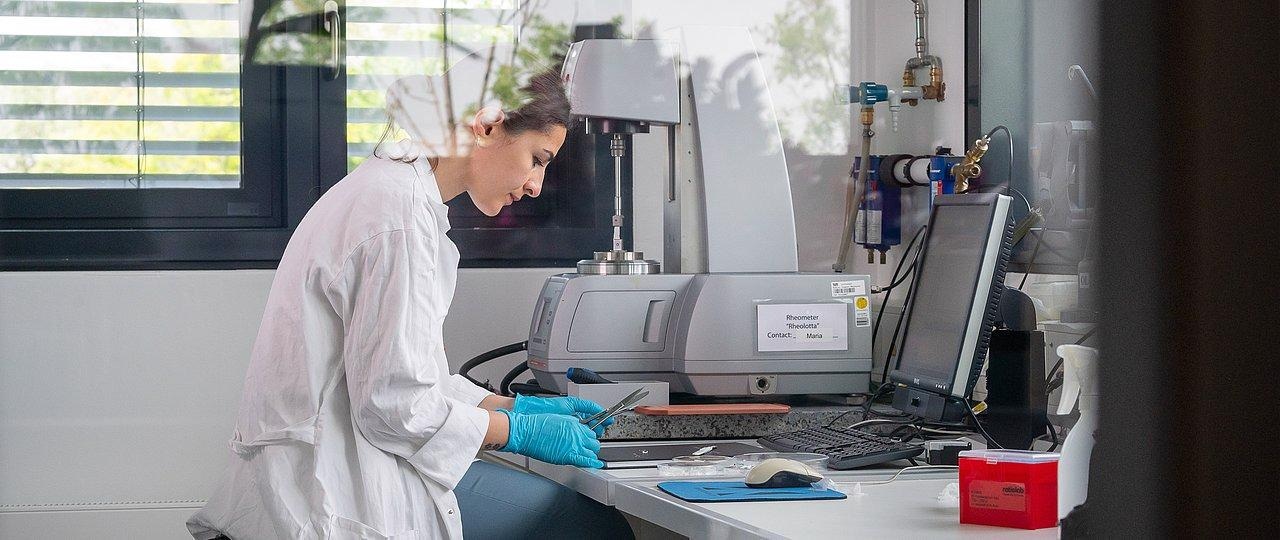Researchers at the Technical University of Munich (TUM) have developed a film that protects wounds similar to the way a bandage does, but also helps wounds to heal faster, dampens inflammation, repels bacteria, releases active pharmaceutical ingredients in a targeted manner and dissolves by itself. This is all possible thanks to its design and the use of mucins - molecules that naturally occur in mucous membranes.
 Ceren Kimna, a doctoral candidate at the Technical University of Munich, examines the newly developed film for wound healing. Image Credit: Astrid Eckert/Technical University of Munich
Ceren Kimna, a doctoral candidate at the Technical University of Munich, examines the newly developed film for wound healing. Image Credit: Astrid Eckert/Technical University of Munich
Traditional bandages are useful for healing minor skin abrasions, but soft-tissue injuries, such as those on the tongue or sensitive regions like the intestines, are more difficult to treat.
The researchers attempted to find answers to questions like what kind of substance will cling to the tissue without hurting it or adhering to nearby points, how can external effects and microorganisms be kept from wounds, and what type of material can allow cells beneath the wound to close it and then vanish without a trace were under the consideration of scientists.
Despite recent advances in producing materials that fulfill some of the above-mentioned special needs, establishing a multifunctional all-in-one solution remains a problem. A team led by Oliver Lieleg, Professor of Biomechanics at the Technical University of Munich (TUM), has created a biopolymer film that can perform a variety of roles simultaneously.
The biomolecular “bandage” demonstrated extremely encouraging results in recent research and is ready for additional testing and modification.
A Multi-Functional Bandage for Sensitive Surfaces
When dry, the thin and flexible film can be picked up with tweezers and can easily be placed onto a wound. Upon contact with moist tissue, the bottom side of the film becomes squishy and sticky and adheres to the tissue by itself - without requiring additional fixation.
Ceren Kimna, Study First Author, Technical University of Munich
Lieleg and his colleagues demonstrated that these biomolecular dressings can cling to smooth surfaces like cartilage and wet tissue like the tongue without causing damage to the tissue. The use of this film to cover a skin wound sped up the healing process.
One of the goals of this research was to create a material combination that dissolves fully on its own after several days without leaving a trace. Using high-resolution microscopy photos of treated tissue samples, the researchers were able to show this characteristic in their studies.
Different Properties on the Top and Bottom Sides of the Film
The film is made up of two layers, allowing each side to be customized to perform certain duties. The thin layer is stabilized by a biodegradable polymer on the upper side, which also includes mucins.
Mucins are molecules which occur naturally on mucous membranes of our bodies. Here, we have used them for the first time in biomolecular films to support wound healing. They provide important properties to protect the wound during the healing process: They have anti-bacterial properties, dampen inflammation and prevent unwanted cells from colonizing the wound.
Oliver Lieleg, Professor, Biomechanics, Technical University of Munich
Professor Lieleg has spent more than a decade studying these molecules.
The film’s bottom side includes hyaluronic acid, a substance renowned for its ability to bind water and facilitate wound healing. Other molecules are chemically bonded to those hyaluronic acid macromolecules, ensuring that the film becomes sticky when exposed to moisture, allowing the film to spontaneously cling to a tissue.
Antibiotics and other active medicinal compounds can be included in the bottom layer if required. The two-layer construction allows the active substances to be released in just one direction and that is towards the wound.
Steps Toward Medical Application
Numerous animal tissue samples have been evaluated with the proposed material combination so far. Furthermore, the team was able to show quicker wound healing in animal experiments, which is a crucial step toward clinical use.
Additional research will be conducted to determine the bandage’s appropriateness for usage with human patients in the future.
These bandages could also be tailored to certain application scenarios and tissue types in the future. Since the films disintegrate in the presence of moisture, they have the potential to be utilized in surgery to cover inside wounds that are otherwise inaccessible, such as when a suture has been applied to close an incision.
Journal Reference:
Kimna, C, et al. (2022) Multifunctional “Janus-Type” Bilayer Films Combine Broad-Range Tissue Adhesion with Guided Drug Release. Advanced Functional Materials doi:10.1002/adfm.202105721.